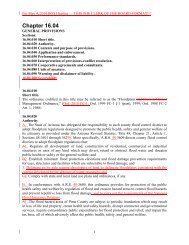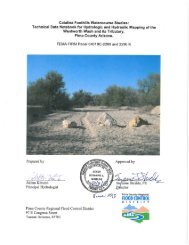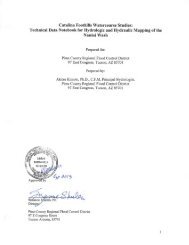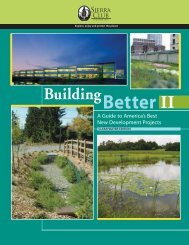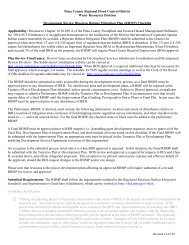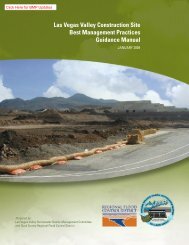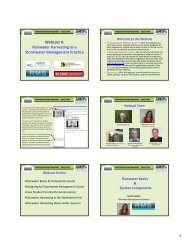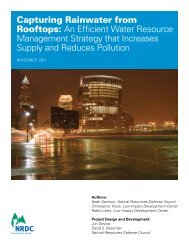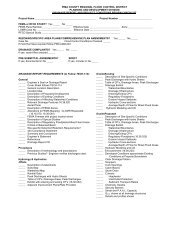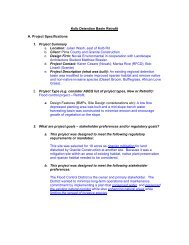WATER HARVESTING INITIATIVES IN TUCSON AND PIMA COUNTY
WATER HARVESTING INITIATIVES IN TUCSON AND PIMA COUNTY
WATER HARVESTING INITIATIVES IN TUCSON AND PIMA COUNTY
You also want an ePaper? Increase the reach of your titles
YUMPU automatically turns print PDFs into web optimized ePapers that Google loves.
<strong>WATER</strong> <strong>HARVEST<strong>IN</strong>G</strong> <strong><strong>IN</strong>ITIATIVES</strong><strong>IN</strong> <strong>TUCSON</strong> <strong>AND</strong> <strong>PIMA</strong> <strong>COUNTY</strong>June 8, 2012Arizona-Mexico Commission, Tucson, AZIrene Ogata, RLA, CPMEvan Canfield, Ph.D, P.E.Urban Landscape ManagerChief HydrologistOffice of Conservation &Pima County RegionalSustainable DevelopmentPowerpoint TemplatesFlood Control Page 1
Presentation Outline• Motivations• Regulatory Framework• Rainfall and RunoffCharacteristics• Initiatives• SummaryPowerpoint Templates Page 2
Presentation Outline• Motivations–Water Scarcity–Clean Water ActRequirements• Regulatory Framework• Rainfall and RunoffCharacteristics• Initiatives• SummaryPowerpoint Templates Page 3
GoalDemand Management Goal #5:Increase the use of rainwater andstormwater to reduce demands onpotable suppliesAction PlanDemand ManagementAction Plan #7:Develop Design guidelines forneighborhood stormwaterharvesting to encourage thecreation of habitat and waterefficient landscapes.Powerpoint Templates Page 4
Low Impact Development andGreen InfrastructureLow Impact Development(LID)‘A comprehensive stormwatermanagement and site-designtechnique. . . the goal of anyconstruction project is to designa hydrologically functional sitethat mimics predevelopmentconditions…’Green Infrastructure‘As a general principal, GreenInfrastructure techniques usesoils and vegetation toinfiltrate, evapotranspirate,and/or recycle stormwaterrunoff…’Powerpoint EPA Green Templates Infrastructure Homepage - Glossary Page 5
Low Impact Development (LID)Mimic pre-development hydrologyLIDPlanningLIDFlowPaths• Disconnect andminimizeimpervioussurfaces.• Maintain predevelopmentwaterways.• Lengthen androughenoverland flowpaths.Source: Low Impact Development Center• Perviouspavement.• Swales, filterstrips.• Bioretention.• Rainwatercatchmentsystems.• DetentionPowerpoint Templates basins. Page 6LIDInfiltration/Features
Presentation Outline• Motivations• Regulatory Framework• Rainfall and RunoffCharacteristics• Initiatives• SummaryPowerpoint Templates Page 7
Regulatory Efforts to Encourage IntegratedUse of StormwaterRegulatory:AZPDES:MS4• City of Tucson• Commercial Water Harvesting Ordinance + DevelopmentStandards (2010)• Stormwater Discharge Permit (AZPDES)• General Plan Green Infrastructure component.• Pima County:• Revised Detention/Retention Manual (expect – 2012)• Stormwater Discharge Permit (AZPDES)• Town of Oro Valley:• Stormwater Ordinance and Stormwater Utility• Measurable Goal: The county shall include in the fourth(4th) year annual report the findings of how theimplementation of LID practices would contribute to thereduction of pollutants in stormwater discharges to theMS4 and identify a plan and schedule for incorporationinto design standards.Powerpoint Templates Page 8
Probability of Runoff FromImpervious Surfaces0.06Runoff Depth (inch) x Probability of Event0.050.040.030.020.010Runoff (inch) x Probability of Rain Event0.5" Design ‐ 66% of Runoff Captured1" Design ‐ 90% of Runoff Captured1.5" Design ‐ 97.2% of Runoff Captured2" Design ‐ 98.6% of Runoff CapturedPowerpoint Templates Page 11Rainfall Depth (inch)0 0.5 1 1.5 2 2.5 3
‘Harvestable’ Water (Rainwater/Stormwater)i.e. water yield100%90%Lot Scale(< 2 ac)NeighborhoodScale(2 ac to 64 ac)TributaryWatercourseRegionalWatercourse(> ~100 mi 2 )Harvestable Stormwater80%70%60%50%40%30%20%10%USDA ARS DataUSGS GageRegression forUndevelopedWRRC DataRooftopModel DevelopedModel UndevelopedRegression for Developed0%0.000001 0.00001 0.0001 0.001 0.01 0.1 1 10 100 1000 1000Area (sq mi)Powerpoint Templates Page 12
Data Sets• Daily Rainfall Data – 108 years ofdata gathered at U of A.• Mean Daily Reference ET (ETo) –from Campbell Avenue FarmPenman Monteith ETo (in/day)0.350.30.250.20.150.10.0500 30 60 90 120 150 180 210 240 270 300 330 360Day of YearPowerpoint Templates Page 13
Data Sets• Daily Rainfall Data – 105 yearsof data gathered at U of A.• Mean Daily Reference ET (ETo)– from Campbell Avenue FarmETo (in/day)0.40.30.20.100 30 60 90 120 150 180 210 240 270 300 330 360Day of YearPowerpoint Templates Page 14
Lot Scale Evaluation(1/5 acre lot example)Right ofWayEvaluate Effectiveness of Water Harvesting FeaturesLotWidthRoadwayWater Harvesting BasinDirectly Connected Impervious AreaUnconnected Impervious AreaDirectly Connected ImperviousAreaPerviousAreaLengthPowerpoint Templates Page 15
Conceptual ModelDirectly Connected Impervious Area(DCA)Unconnected Impervious Area (UA)ConceptualRepresentationPervious Area (PA)Water Harvesting BasinMathematical Representation2( P 0.2S)Q ( P 0.8S)Q is the total depth of runoff (inches);P is the daily rainfall depth of precipitation (inches);S is the potential abstraction (inches)CN is the Curve Number.Storage Accounting in Basin:Storage(i)S1000 10 CNRainwater off lot from Directly Connected:Vol ( DCA)i Qi( f ( CNDCA,Pi)]xAreaDCARainwater in to Water Harvesting Basin:Vol ( UA)i Qi( f ( CNUA,Pi)]xAreaUAVol ( PA)i Qi( f ( CNPA,Pi)]xAreaPA Storage(i 1) StoragePowerpoint Templates Storage Rainwateri ETi Page 16(ETo AZmet * Kc)
Modeled Mesquite WaterRequirements (ET) and WaterHarvested5.004.504.00StormwaterHarvestedETAverage Depth (in)3.503.002.502.001.501.000.500.00Powerpoint Templates Page 18MonthJan Feb Mar Apr May Jun Jul Aug Sep Oct Nov Dec
Presentation Outline• Motivations• Regulatory Framework• Rainfall and RunoffCharacteristics• Initiatives–Initiatives of LID WorkingGroup–Jurisdictional Initiatives• SummaryPowerpoint Templates Page 19
Joint Effort: LID Working Group MembersPublic: PimaCo.Regional Flood Control DistrictPublic: City ofTucsonOffice of Conservation& Sustainable DevelopmentDevelopment Services Dept.Dept. of. TransportationDept. of Transportation:Stormwater DivisionEducation: Univ. ofArizonaEnvironmentalResearch LabDrachmanInstitutePublic: Pima Assoc. ofGov.FacilitiesBiosphere 2Water ResearchResource CenterNon-Profit/OtherProfessional/TradeNorris DesignWheat Scharf & Assoc.Watershed ManagementGroupLiving Streets AllianceImagine Greater TucsonPowerpoint Templates Page 20
Joint Effort – LID Working GroupProducts of the LID WorkingGroupRevised PimaCountyDetention/RetentionManualNeighborhoodScale WaterHarvestingManualCaseStudiesCataloguePowerpoint Templates Page 21
Joint Effort – LID Working GroupProducts of the LID WorkingGroupRevised PimaCountyDetention/RetentionManualNeighborhoodScale WaterHarvestingManualCase StudiesCataloguePowerpoint Templates Page 22
Pima County:DETENTION–RETENTION MANUAL(Draft)4.5Replace Retention Requirement with a‘First Flush’ Retention RequirementDaily Precipitation (inch)4.03.53.02.52.01.51.00.585th Percentile Rainfall0.48 inch0.00% 20% 40% 60% 80% 100%PercentPowerpoint Templates Page 23
Bioretention BasinPowerpoint Templates Page 24
Terraced DetentionBasin withRetentionPowerpoint Templates Page 25
Pima County:DECENTRALIZED ‘FIRST FLUSH’ RETENTIONPowerpoint Templates Page 26
Joint Effort – LID Working GroupProducts of the LID WorkingGroupRevised PimaCountyDetention/RetentionManualNeighborhoodScale WaterHarvestingManualCase StudiesCataloguePowerpoint Templates Page 27
May 25, 2012Table of Contentsi. Preface and Acknowledgmentsii.How to Use this Manual1. Introductiona. Purpose and Goalsb. Background and Local Context (…note existing local practices…)c. Scoped. Integration with other Efforts (mention TW rebate, COT Water Harvesting)2. LID and Water Harvesting Principlesa. Why Use LID?b. Low Impact Development and Rainwater Harvesting Terminologyc. Neighborhood Scaled. Local Rainfall Characteristicse. Stormwater and Water Qualityf. The Effect of Development on Soil Infiltration Properties3. Site Assessment, Design and Planning Processa. Site Hydrologyi. Stormwater Design Volumeii.b. Water Quality and Treatmentc. Erosion and Sediment Controld. Urban Heat Island Mitigatione. LID Practice Selection Matrixi. Decision Treeii. Integrated Managementiii. Benefits and Costs4. LID Practicesa. Non‐Structurali. Clustered Developmentii. Minimizing Disturbed Areas and Soil Compactioniii. Promoting Open Spaceiv. Preserving Natural Flow Paths and Buffersv. Conserving and Restoring Sensitive Natural Areasvi. Disconnection of Impervious Areab. Structurali. Stormwater Harvesting Basinsii. Swalesiii. Bioretention systemsiv. Infiltration TrenchesPowerpoint Templates Page 28v. Dry Wells
Neighborhood-ScaleWater Harvesting ManualTypeAgency / JurisdictionCity of SantaBarbaraLocalPriorityPretreatmentBioretentionFiltrationInfiltrationRunoff VolumeMinimizationEnd of PipeResearch TeamMemberAssignmentsSW BMP GuidanceDocumentManualDate of Publication 2008high Best (LID) Site Design Practices (Non Structural BMPs) Xhigh O Natural/Sensitive Area Conservation/Restoration Ohigh O Impervious Area Disconnection Ohigh O Minimize Impervious/Disturbed Areas Ohigh O Cluster Development (Minimize Construction Footprint)high O Minimize Soil CompactionStantec (JT)high O Protect/Use Natural Flow Paths and Buffers Ohigh O Promotion of Open Space Design/Natural Infiltrationhigh O Implement Source Controlsmedium X X Media Filters / Filtration Devices Xhigh X X Sand Filter and Gravel Filters XEricmedium X Hydrodynamic / Solids Removal Devices Xmedium X Oil and Water Separatorshigh X Bioretention / Rain Gardens Dave Xhigh X Tree Pits / Tree Box Filters / Planters Irene Xhigh X Xeriscaped Buffers / Filter Strips / Swales Evan Xhigh X Dry Wells Evan Xhigh X Infiltration Basin / Systems XStantec (JT)high X Infiltration Trench or Gallery Xhigh X Soil Amendments / Structural Soils Irene Xhigh X Porous/Pervious Pavements Irene Xhigh X Rainwater Harvesting for Use (Rain Barrel / Cistern) Irene Xhigh X Self‐Treating Areas (Zero Discharge Microbasins) Dave Xhigh X Downspout Disconnection / Redirection Stantec (JT) Xhigh X Detention Basin / Gallery / Dry Ponds Stantec (JW) Xhigh X Retention Basin Stantec (JW)medium Diversion Structures / Flow Splitters / Green Outlets Stantec (JT) Xhigh Source Controls (Non Structural BMPs) X? O Runoff Volume Minimization O? O Manage Potential Stormwater Hotspots? O Roof Runoff Protection? O Runoff Quality Protection OManage Potential Stormwater HotspotsPowerpoint Templates Stantec (JT)Page 29
Joint Effort – LID Working GroupProducts of the LID WorkingGroupRevised PimaCountyDetention/RetentionManualNeighborhoodScale WaterHarvestingManualCaseStudiesCataloguePowerpoint Templates Page 30
Case Studies CatalogueTucson Water: East Side Service CenterPowerpoint Templates Page 31
Case Studies Catalogue20-30 Park (Highland Vista Park):Collector street – residential land useNative vegetation irrigated with harvested stormwater,reduced ponding and associated mosquito problemsPowerpoint Templates Page 32
Case StudiesScott Avenue: Collector street - commercial land usesPowerpoint Templates Page 33
Presentation Outline• Motivations• Regulatory Framework• Rainfall and RunoffCharacteristics• Initiatives–Initiatives of LID WorkingGroup–Jurisdictional Initiatives• SummaryPowerpoint Templates Page 34
City of TucsonOrdinanced: Commercial Rainwater HarvestingPowerpoint Templates Page 35
City of TucsonApproved: Curb cut standardsPowerpoint Templates Page 36
Initiatives of Tucson Water• Demonstration Projects (13)• Residential Water HarvestingRebate Program– Required Training– Two Levels• Implement training concepts.• Prepare design to capture 1”rainfall.Powerpoint Templates Page 37
Initiatives of Oro Valley• Rainwater HarvestingOrdinance• Stormwater UtilityPowerpoint Templates Page 38
Presentation Outline• Motivations• Regulatory Framework• Rainfall and RunoffCharacteristics• Initiatives• SummaryPowerpoint Templates Page 39
SummaryMotivation forGI/LID:• Reduce need for additional groundwater pumping by providingnon-potable water source for street landscaping• Alternative management strategy for residential street stormwaterrunoff• Use LID practices to mitigate flooding• Promote small urban waters restorationMitigate Urban Heat IslandExistingReq’ments:• The City of Tucson and Pima County have 4 years to determine ifhow to implement LID.• Water Harvesting Ordinance requires commercial sites to supply50% of irrigation need (Tucson).• Required to consider water harvesting for comprehensive planammendments (Pima County).NextSteps:• Finalize new Detention/Retention Manual (Pima County).• Develop City-County Neighborhood Scale Water HarvestingManual• Compile Case Studies CatalogPowerpoint Templates Page 40
Acknowledgements• Dave Stewart (RFCD) developedthe water harvesting creditmethodology.• Ann Moynihan and PatriciaGilbert (RFCD) led the effort toupdate the Detention/RetentionManual.• City of Tucson Water HarvestingTechnical Advisory Committeeassisting to create methodology forDevelopment Standards submittalsPowerpoint Templates Page 41
ResourcesCity-County Water Study White Paperon Stormwaterhttp://www.tucsonpimawaterstudy.com/Reports/Phase2/Stormwater.Mgt.Tech.Paper.pdfCity of Tucson Water HarvestingOrdinancehttp://www.tucsonaz.gov/ocsd/sustainability/water/rainwaterharvesting.phpLID Working Group Websitehttp://rfcd.pima.gov/pdd/lid/workinggroup.htmAridLIDhttp://www.aridlid.org/Powerpoint Templates Page 42
QuestionsEvan Canfield: evan.canfield@rfcd.pima.govIrene Ogata: irene.ogata@tucsonaz.govPowerpoint Templates Page 43
Next Steps:CITY-<strong>COUNTY</strong> <strong>WATER</strong>-WASTE<strong>WATER</strong><strong>IN</strong>FRASTRUCTURE & PLANN<strong>IN</strong>G STUDYMarch 21,2011 LIDWorkshopInitiate aDialogueAmongExperiencedProfessionals in aWorkshopSettingForm LIDWorkingGroup ofInterestedProfessionalsProvideInput tothePlanningof 2012RegionalLIDConferenceIdentifyMotivationfor LID /GI inSouthwestIdentifyNeed forResearch/Design LIDVision forSouthwestConsiderEducational VenuesandTargetAudiencePowerpoint Templates Page 44
MilagroCost EffectivenessWhat ADEQ Says In their FactSheet•EPA has found that in most . . . LID/GI practices savesmoney and enhances property values for developers,property owners, land managers and communitiesthroughout the nation.Minimzed Site GradingReduced Landscaping CostReduced Site PavingHow Reduced LID Drainage Can Reduce Infrastructure Costs•…..in the vast majority of cases, …Total capital costsavings ranged from 15 to 80 percent when LIDmethods were used (EPA Case Studies, 2007).•Developers expect economic Reduced advantages Pavingincludingincreasing the number of developable Better Stormwater lots and Management reducingcosts on stormwater infrastructure Reduced (EcoNorthwest,Landscape Watering2009).Powerpoint Templates Page 45



